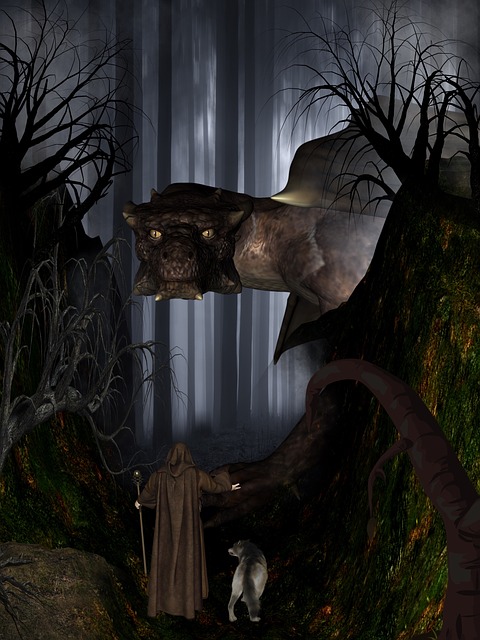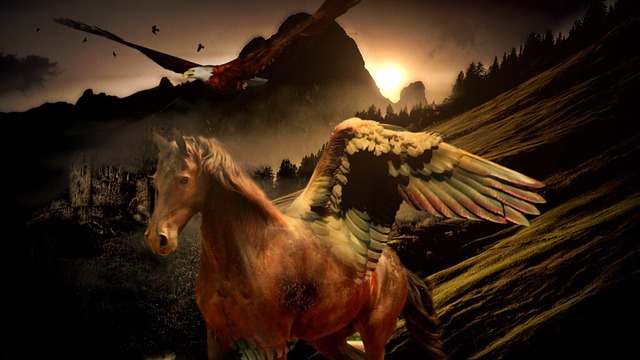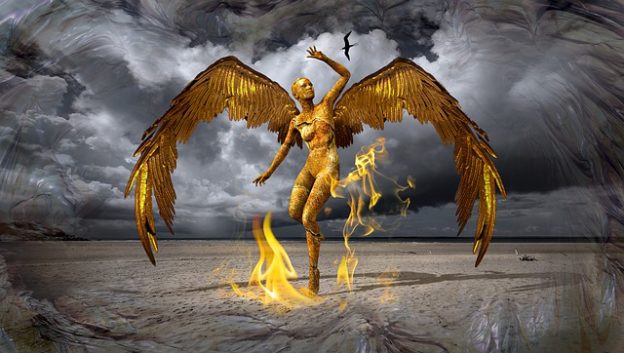Many religions and esoteric traditions embrace the transcendent power of the human soul. The soul is believed to be the source of intuitive insight and creative genius, giving rise to divine flashes that connect one to an ‘intelligent other’ often considered as an autonomous god, spirit, angel, muse or daimon; or alternatively understood as a facet of the human imagination or collective unconscious in a Jungian sense. Whether it comes from the artist, the monk, the shaman, the medium or the mystic, communication with this other order of reality is commonly attributed.
This article explores daimonic presence in a variety of aspects, presenting fresh insights into our shared relationship with the mysterious and numinous dimensions of reality. The purpose is not to prove or disprove the existence of such realms and beings, but rather to evoke their validity through the perspectives of history, art, literature, philosophy, psychology and science, demonstrating how they inform, and have always informed, human experience.
The Anima Mundi
In his work Timeaus, Plato first described the World Soul, also known as the Anima Mundi, which depicts the universe as a single living creature that contains all living beings within it—the soul of the cosmos—the intelligent and harmonious principle of proportion and relatedness that exists at the heart of the cosmic pattern and allows the living world to unfold in divine confluence.
“…Therefore, we may consequently state that: this world is indeed a living being endowed with a soul and intelligence … a single visible living entity containing all other living entities, which by their nature are all related.” Plato, Timeus, 29/30; 4th century B.C.
This concept of an interrelated and beautifully ordered universe, animated in much the same way as the human soul animates man’s body, captured the imagination and admiration of numerous philosophers and theologians though the centuries. However, the scientific revolution of the sixteenth and seventeenth centuries came to describe the world in mechanistic terms, with intelligence belonging only to humans or to detached, theoretical deities, with no existent living connection with the universe. This engendered a profound alienation and denied human beings an inherent and vital bond with the living, breathing world around them.
Poets and philosophers of the Romantic era resisted this mechanical world view, and eventually discoveries in science, particularly in quantum physics and the principles of a unified field of conscious energy, presented seminal challenges to the Newtonian premises upon which much of traditional scientific theory is based. Consequently, the compass point of science appears to have pivoted toward this ancient metaphor of nature’s innate and majestic sentience, the World Soul, the Anima Mundi.
Hallowed Emissaries
In the original Christian reception of Platonism, daimons were identified with angels. The ancient Greeks viewed them as intermediaries between humans and the gods, spiritual advisers of a sort. Daimon literally means ‘divine power’, ‘fate’ or ‘god’. For our purposes, daimon (the Latin spelling of which is daemon) is recognized as a term that for many centuries was a respected characterization of these hallowed emissaries. Unfortunately, as Christianity transformed perception of pagan deities, traditions and rituals into agencies of Satan, the word daimon morphed into demon and came to represent hideous creatures of evil.

“We not only live among men, but there are airy hosts, blessed spectators, sympathetic lookers-on, that see and know and appreciate our thoughts and feelings and acts.” ~Henry Ward Beecher
By drawing on a philosophical tradition that flows down the centuries from the Platonists through the Romantics, and crucially in the poetry of William Bake and William Butler Yeats and the literary works of James Joyce, to the groundbreaking contributions of imminent psychologist Carl Gustav Jung—and the seminal interpretations of Jung’s work by renowned mythologist Joseph Campbell—one may trace an ancient history of understanding and embracing a daimonic reality, an alternate realm, an otherworld. This daimonic reality is the archetypal landscape of folklore and myth that populates cultures from antiquity, the perception of our world interpenetrated by another, shadowy yet powerful reality, one full of wonder, beauty and terror.
Indeed, Jung and Campbell would contend that this is not merely a realm of the individual psyche, but of the collective psyche of the cosmos, the World Soul, the Anima Mundi. The cave paintings of indigenous tribes, some of which include serpents of both wing and water, as well as strange beings with exaggerated eyes and large craniums thought to be ‘star people’. Dwarves, fairies, gnomes, elves and other ‘light creatures’, the legendary wee folk of ancient Celtic civilization, hidden magical beings which are still intrinsic to the cultures of Iceland, Western Europe and Russia. Dragons, centaurs, unicorns, trolls, winged lions; these are but a few examples of daimons rooted in myths that are prevalent in every civilization across the world, presences that aggregate the imaginal plane of the Anima Mundi.
The Magnum Opus
The World Soul then, with all its presences, is not a fixed or defined phenomenon but rather a fluid entity comprised of the hopes, dreams and deepest imaginings which mankind shares with all living beings. This is the home of creation’s collective memories and the fantastical myths of humanity. Here are the arcane archetypes and powers that define our lives. Here are hidden destinations of magical meaning, places where dreams come into being. We are raised and live in a stark and barren landscape of rationality and reason, such that we easily forget the potency that lies just beneath the surface, connecting our divine wisdom in all its mystery and wonder. By exploring the pathways created by our conscious connection to the Anima Mundi, our light energy, our force of being, embarks upon magical journeys to alternate dimensions of conviction and purpose that exist within the world, places where deeper layers of meaning are waiting to come alive.

“The psyche is the inward experience of the human body, which is essentially the same in all human beings, with the same organs, the same instincts, the same impulses, the same conflicts, the same fears. Out of this common ground have come what Jung has called the archetypes, which are the common ideas of myths.” ~Joseph Campbell
It is no coincidence that the numinous realities of the Anima Mundi, the fantastical otherworlds of folklore and myth, are places of magical enchantment and alchemical wonder. Historical evidence of the existence of alchemy and magic is spread all over the globe, from compendiums that document rituals, practices, and techniques to historical texts describing these practices in context, including inscriptions, temples, sanctuaries and special tools used for such purposes. Over time, a separate branch of archeology emerged that deals with the discovery, research and interpretation of such items.
The Magnum Opus, also known as the Great Work, was the process in Western alchemy meant to create the Philosopher’s Stone, a primordial substance allegedly capable of transmuting inexpensive metals into gold, and from which the elixir of life could be derived. Jung published several major works on alchemy and is considered responsible for the subject regaining respect in academia. At the culmination of his career, Jung’s primary focus of research was alchemy and its relationship to the dynamics of consciousness. He perceived the turning of base metals into gold as symbolic of personal transformation, a metaphor for the alchemy of individuation and the morphing and mutating imagery of that process, which emerges from our stream of consciousness. The images and operations Jung encountered in his extensive studies of old alchemy texts related strongly to his theories of psychoanalysis and the unconscious.
Those unfamiliar with the subtle nuances of alchemy view it as the historical predecessor of our modern sciences. Yet Jung’s research revealed a far deeper, spiritual significance to the alchemical process. It is relevant to note that there is no single form of alchemy for one to examine. Alchemy is a cross-cultural phenomenon practiced in various forms by ancient Egyptians, Greeks, Romans, Christian Europeans, and the Islamic, Hindu, and Taoist faiths. Yet all of these use symbols to depict a process of transformation, such as the Philosopher’s Stone, which contains the knowledge of creation and bestows enlightenment upon the maker, converting the base metal of his outer character to the golden properties of his higher self, thus concluding the Great Work, the Magnum Opus.
Mythical Reality
From physicists such as the late Stephen Hawking, as set forth in his book A Brief History of Time, and Nassim Haramein in his acclaimed Resonance Project, among others, there is mounting evidence that consciousness is a non-local constant of the universe, an interactive, unifying field of intelligent energy with which we connect. We then individuate this consciousness according to our own sensual interrelationship with the environment around us. These revelations, coupled with the fact that the existence of our physical world beyond subjective perception and sensory interaction has yet to be proven by science, merit credible contemplation of realities beyond our immediate discernment.

“In art, in myth, in rites, we enter the sphere of dream awake. And as the imagery of dream will be on one level local, personal, and historic, but at bottom rooted in the instincts, so also myth and symbolic art. The message of an effective living myth is delivered to the sphere of bliss of the deep unconscious, where it touches, wakes, and summons energies; so that symbols operating on that level are energy-releasing and -channeling stimuli.” ~Joseph Campbell
As science evolves beyond the mechanistic, Newtonian worldview and ventures into the reckoning of consciousness as an equation of energy, a renaissance of spirituality and the concept of divine intelligence is occurring. We are challenged to consider ancient yet enduring paradigms such as mythology and the Anima Mundi as more than mere psychological or philosophical concepts. The World Soul, replete with its fantastical realms of transformative magic, sublime mystery, and archetypal beings of wonder and terror, is a living, spiritual force within us and around us; it pervades all of creation and is a unifying principle within the world.
Indeed, these are the alchemical forces that help us heal and transcend the spiritually bereft state of individualism; to realize the primal truth of oneness and reunite with the whole. The science of the future will embrace these ethereal dynamics and explore how the physical and mythical realities interrelate, including how these daimonic presences of conscious and intelligent energy interact with and channel the forces of the universe. The shaman and scientist will work together to illuminate the shadowy depths of understanding, while the priestess and the physician renew their ancient connection of healing wisdom.
Acknowledging daimonic presences and reuniting with the Anima Mundi liberates one from the stranglehold of materialism, awakening the soul to more meaningful purposes and dreams. Along the golden path of alchemical transformation we begin to see life differently; a new and perhaps even mythical reality becomes visible, filled with enchantments and infinite possibilities. Suddenly, we are aware of a different world that was always around us yet hidden from sight, one that does not belong to buying and selling but to the mystery of the soul. As our sense of wonder and awe is redeemed, the same redemption occurs within the psyche of the World Soul; and thus, guided by these hallowed daimons of living myth, we learn to wield the ancient magic of creation.
References
- Encyclopedia.Com
- Stanford Encyclopedia of Philosophy
- Encyclopedia Britannica
- The Gnosis Archive
- Resonance Science Foundation
- A Brief History of Time
©2018 by Shawn Quinlivan, C.Ht. & Cathexis Therapeutic Imagery. All rights reserved.

